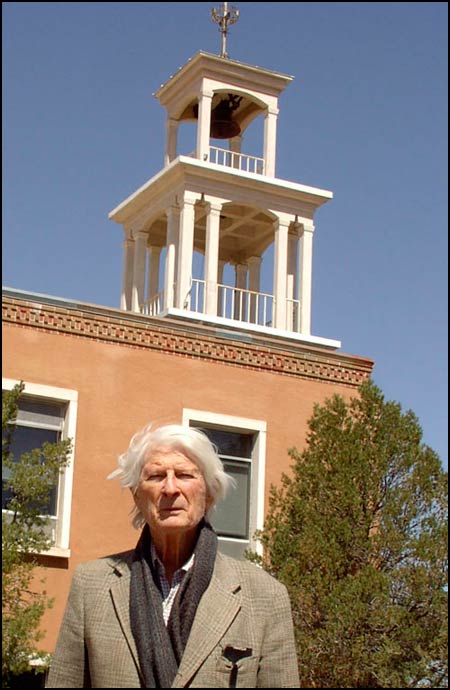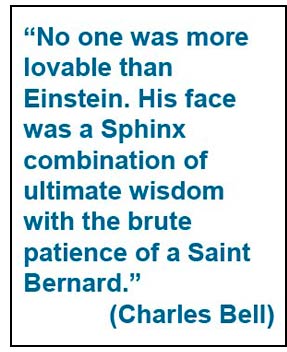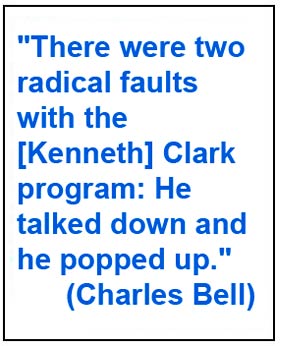 Symbolic History
Symbolic History Most men who like to tinker in their basement will probably have an odd assortment of tools, a pile of scrap lumber, maybe a junked lawnmower strewn across a workbench, and a couple of empty cans of 10-W-40 lying around. But St. John s College tutor Charles Bell is a tinkerer of a distinctly different color: He tinkers with the history of the Western World, fiddling with it here, adjusting it there, or fine-tuning it at some crucial spot, making it yield new insights or startling revelations.
What are his tools? A magnifying glass, a poetic imagination, a collection of some of the world's greatest music, and file cabinets filled with nearly 30,000 color slides representing the great art works of Western Civilization. Bell, 65, does not guard his culture cache like some pedantic hermit, nor does he keep his work under wraps like some defensive, workbench Edison. Instead, he has transformed this awesome collection — he took most of the slides himself — into a series of 40 shows that combine art, music, literature and narrative, and depict the ebb and flow of ideas in the West since the time of t he pharaohs.
he pharaohs.
"What I'm trying to do is create a new type of dramatic art," he said during a recent evening showing at the Anne May tag house in Nambe. ''I'm not merely trying to teach a simple lesson with my shows, I'm trying to create new art." The widespread distribution of his work. would, in his own words, signal the beginning of a "Bell-arts revolution."
Unlike the vast majority of academicians in the 20th century, Bell is a generalist, not a specialist. While most professors want to stake out a tiny amount of territory and study it in great depth, he wants to bring it all together and, by synthesizing it, come up with some general conclusions about the historical process.
For example, in his lecture on 20th Century art, "The Avant-Garde Break," he shows a slide of Edvard Munch's stark painting "The Scream" while a dissonant selection from Mahler's Ninth Symphony plays under Bell's reading Rainer Maria Rilke's poem "Duino Elegies: Who, if I cried, would hear me among the angel orders?"
For some it may seem like sensory overkill, but there can be no question that the compression of three different art modes into the same moment is a direct and powerful way to communicate the anxiety felt by 20th Century artists.
It might seem that Bell's multimedia lectures are a bit old-hat in the face of Kenneth Clark's highly touted television series "Civilization" or J. Bronowski's "The Ascent of Man," were it not for the fact that Bell conceived his lecture series in 1938, long before television.
He was in Paris, taking a short vacation from his studies at Oxford, when he went into a record store. He descended the stairs to the basement and went into one of the "air less booths" set up for prospective buyers who wished to hear a record before they bought it. There he listened to rare selections of medieval and renaissance music. Suddenly, something clicked. His art and literature studies at Oxford were complemented, reinforced and enriched by listening to those rare recordings. It was then I realized the whole historic interplay between music and art. It was as great a day I ever experienced in my life," Bell said.
Though the thought of portraying the evolution of Western Civilization through its arts intrigued Bell immediately, it wasn't until 1940 and the development of Kodachrome that he was able to begin amassing the vast number of slides of paintings, sculpture and architecture that he would need to carry out his project. Simultaneously, he began collecting recordings of the great music of the West, from medieval plainsongs to Stravinsky.
The real seed of this life work — "a symbolic history" of Western Civilization, he calls it — was planted when he was a student at the University of Virginia. Something of a debater, Bell got into a heated argument with his professor, Stringfellow Bar — who would later become the president of St. John's College — over Oswald Spengler's theories of historical cycles.
"I originally set out thinking of myself as a scientist and philosopher," Bell said. "But I decided that I also had to know something about man as well. And, as Barr told me, there is no way to study the history of man except through his artifacts." And, as Bell discovered, none of man's handiworks was more stimulating, more rewarding, or more revealing than his art, music and literature. Quite a turnaround for a man who began hls academic career pursuing physics and math.
But Bell didn't turn his back on the sciences completely. During World War II a government project in electronics research brought Bell to Princeton University, where he met his longtime hero Albert Einstein.
"He was a marvelous man," Bell reminisced. "I don't think he really cared much about the circumstances of living. One time I went to his house to pick up a sweater one of my children had left there. It was in his room, and when I went in to get it, I noticed his bed had obviously not been made in weeks. And the pillow where he rested that noble head had this crater in it."
Although Bell once idolized Einstein, the argumentative spirit in him eventually lead him to tangle with the Nobel laureate. Fundamentally, Bell objected to Einstein's search for a single-field equation that would restore determinism to the universe. (Bell doggedly believes in a universe of ambivalence and paradox.)
"But certainly no one was more lovable than Einstein," Bell added. "His face was a Sphinx combination of ultimate wisdom with the brute patience of a Saint Bernard."
It was about this time in the early '40s that Bell first began showing his lectures. The reactions from the academic community were "mixed," as they say on Broadway. "This type of thing gets specialists very upset," Bell said. "When you cover the entire history of Western Clvilization in 80 slides, it makes some people in academic circles upset. It cuts across so many disciplines."
Nevertheless, his lectures did find support among some of the highest circles. Literary critic and historian Northrop Frye called Bell's lectures "extraordinary in range and depth of allusion, and a synthesis of a scope that I have not seen anywhere else."
Though Bell insists he is creating a new art, his lectures in Nambe did not seem to be a revolutionary new art form, but the presentation was interesting, uplifting, and in many parts beautiful. His first presentation, "Cycles," was based on Vico's assumption that history is a series of cycles, that all civilizations are destined to rise, decay and fall. Bell reaches back to the three main periods of ancient Egypt to begin his analysis. Through the development of Egyptian art, one sees t he changes in the very soul of the Egyptians that took place through the centuries. Bell does the same for the Greeks and the Romans, working his way up to modern times.
Where the multimedia aspect of "Cycles" was most effective was where the music complemented the particular slides. However, since the music from the ancient world is for the most part lost, Bell had to rely on vocal narration for almost all the first part of "Cycles."
Bell never talks down to his audience. (He faults Kenneth Clark for this: "There were two radical faults with the Clark program: He talked down and he popped up.") And sometimes one gets lost trying to follow his ideas. But in the end, this tendency of his is effective. By the close of one of his shows, the viewer feels that something has indeed taken place "upstairs." And in this age of dime-store gurus and pop psychologists, a true intellectual like Charles Bell is indeed refreshing.
(Note: You can watch some of Charles Bell's Symbolic History shows by pressing this link.)
|
|


